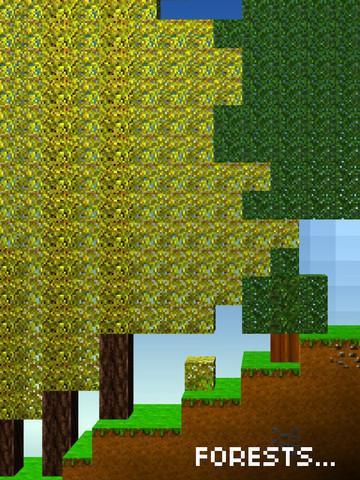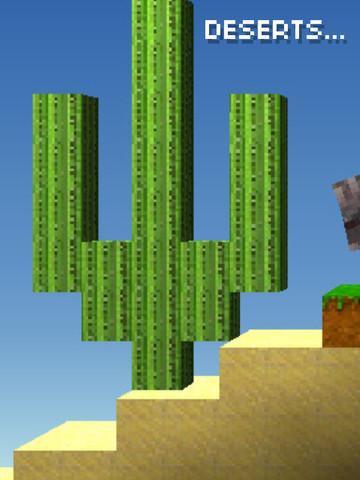- Wondering how to get Monopoly GO! free rolls? Well, you’ve come to the right place. In this guide, we provide you with a bunch of tips and tricks to get some free rolls for the hit new mobile game. We’ll …
Best Roblox Horror Games to Play Right Now – Updated Weekly
By Adele Wilson
Our Best Roblox Horror Games guide features the scariest and most creative experiences to play right now on the platform!The BEST Roblox Games of The Week – Games You Need To Play!
By Sho Roberts
Our feature shares our pick for the Best Roblox Games of the week! With our feature, we guarantee you'll find something new to play!All Grades in Type Soul – Each Race Explained
By Adele Wilson
Our All Grades in Type Soul guide lists every grade in the game for all races, including how to increase your grade quickly!
The Blockheads Review
In an App Store rife with cloning, “Minecraft-style” has essentially become its own subgenre. A quick Google search alone reveals an almost monthly article about the latest attempt by an enterprising studio to bottle the lightning Mojang captured with their “Lego in a Sandbox” phenomenon. It’s no surprise, then, that I dove into Majic Jungle Software’s The Blockheads with considerable skepticism. What is surprising, however, is how much fun I had.

Miney Tower
In an App Store rife with cloning, “Minecraft-style” has essentially become its own subgenre. A quick Google search alone reveals an almost monthly article about the latest attempt by an enterprising studio to bottle the lightning Mojang captured with their “Lego in a Sandbox” phenomenon. It’s no surprise, then, that I dove into Majic Jungle Software’s The Blockheads with considerable skepticism. What is surprising, however, is how much fun I had.
Make no mistake about it. The Blockheads is hoping to stir up discussion with its striking similarity to its most obvious inspiration. Look no further than its game description, which groan-inducingly boasts the ability to “explore, mine, craft and build” in an open world. Unlike many of its ilk that came before it, however, The Blockheads doesn’t end the discussion there and hope to make a slew of sales before people realize they’ve been duped. Rather, Majic Jungle makes some platform-specific changes to Mojang’s blockbuster formula that truly set this title apart.
Foremost among these? Pitch-perfect touch controls. In other would-be Minecrafts – heck, sometimes even in Minecraft: Pocket Edition itself – one of the biggest stumbling blocks to success is the way that moving throughout the environment feels clumsy on your phone and tablet. A half-hearted simulacrum of the sandbox experience you really want, almost tacitly apologizing as it goes: “sorry, but this is the closest we could get.” Here, TheBlockheads avoids this pitfall by re-thinking the genre’s interface ever so slightly.
Everything takes place on a 2D plane, and sending a character around the map is as simple as tapping the spot you want him or her to visit. Tap again and you’ll queue a resource for mining, or task for doing. As you advance in the game, you’ll be handed control of multiple characters, and can in turn multi-task briskly and effortlessly. A seemingly simple change, perhaps, but one that makes all the difference in practicality, rendering The Blockheads an experience that feels wholly different from other imitators. Instead of feeling like you’re investing a whole ton of effort to just barely approximate the Minecraft experience, Majic Jungle instead empowers the player to do a wide variety of things with very little effort, in turn nailing the quintessential feeling that makes Minecraft so special: the sense that you’re in control of a microcosmic world all your own.
Which brings us of course to the crux of the game itself. On one hand, there’s very little point delving deeply into what it is you do in The Blockheads, as it’s a story we’ve all heard many times by now. Gather resources, amass tools, and manage your limited supplies to build and improve the sandbox you inhabit. What’s compelling about The Blockheads, however, is that instead of quietly acknowledging that it won’t win over non-fans of this formula, Majic Jungle once again makes slight changes to smartly pander to a different audience, and trends in mobile gaming. Interwoven throughout the experience is an Animal Crossing-like need to keep your blockheads happy; a trivial but engaging system that gives the player meta-goals through which to improve productivity and optimize tasking.
In addition, the presence of monetizing “time crystals,” which seems at first to be a sleazy concept, emerges as a clear line in the sand seeking to further separate The Blockheads into its own niche. Needed to speed up the completion of tasks and access certain tools, time crystals lend The Blockheads a Tiny Tower sensibility. I mention Nimblebit’s quintessential time management game because of the deftness with which Majic Jungle sprinkles the use of time crystals throughout the game, choosing to make them a mostly-optional way to satisfy power users, instead of a gate behind which to lock the fun of the experience. The end result? A game which rather successfully establishes itself as an impermanent fix for the Minecraft fan riding the bus with their phone, or watching TV with their tablet.
The philosophical question at stake, however – the one which makes me reticent to declare The Blockheads a complete success – is one that arises largely from the constraints of the platform it’s on. Even with the ambitious inclusion of Game Center multiplayer (voice chat-enabled as it is!), The Blockheads is missing the real secret sauce that made Minecraft king of the current gaming zeitgeist: community. The driving force between Minecraft‘s continued success is its hosting on permanent servers, where groups of people can painstakingly recreate Middle Earth, or share in the triumphs of replicating the inner workings of a computer circuit board, or marvel at a 1:1 model of the Starship enterprise. That ability not only to toil away in a made-up world, but to share that made-up world with a much more real one filled with people who share – and embrace – your virtual aspirations. Without that, as fun as it can ever be, I can’t help but wonder: is The Blockheads not just an exercise in “improving productivity and optimizing tasking?”

The good

The bad
More articles...
Monopoly GO! Free Rolls – Links For Free Dice
By Glen Fox
Wondering how to get Monopoly GO! free rolls? Well, you’ve come to the right place. In this guide, we provide you with a bunch of tips and tricks to get some free rolls for the hit new mobile game. We’ll …Best Roblox Horror Games to Play Right Now – Updated Weekly
By Adele Wilson
Our Best Roblox Horror Games guide features the scariest and most creative experiences to play right now on the platform!The BEST Roblox Games of The Week – Games You Need To Play!
By Sho Roberts
Our feature shares our pick for the Best Roblox Games of the week! With our feature, we guarantee you'll find something new to play!All Grades in Type Soul – Each Race Explained
By Adele Wilson
Our All Grades in Type Soul guide lists every grade in the game for all races, including how to increase your grade quickly!








 “
“